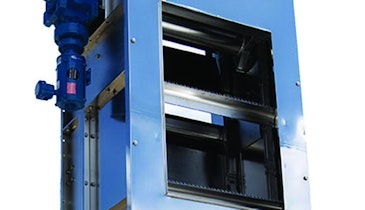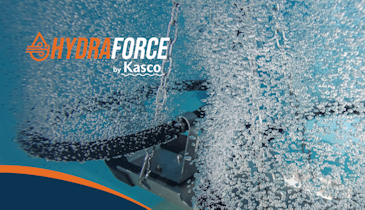Interested in Odor Control?
Get Odor Control articles, news and videos right in your inbox! Sign up now.
Odor Control + Get AlertsA number of methods have been developed to measure trace levels of H2S. The most widely used measurement methods include gold film analyzers, SO2 conversion, colorimetric gas detection tubes, electrochemical detectors, and lead acetate cassette tape gas detectors.
Main considerations when choosing an H2S analyzer include desired detection level, accuracy of measurements, potential interferences, and level of maintenance required to ensure the equipment is working properly.
Gold film sensor analyzers
Gold film sensor technology for use in detecting H2S came onto the scene in the mid-1980s. Developed by AMETEK Arizona Instrument, the Jerome brand of hydrogen sulfide analyzers utilizes gold’s sensitivity to hydrogen sulfide to detect ultra-low levels of H2S in air. To take a sample, an internal pump pulls ambient air over the gold film sensor. The sensor absorbs the hydrogen sulfide present in the sample and undergoes an increase in electrical resistance proportional to the mass of H2S in the sample, allowing the instrument to calculate and display the measured concentration of hydrogen sulfide in parts per million or parts per billion. The most recent gold film hydrogen sulfide analyzer by Jerome, the J605, can detect as little as 3 ppb with a resolution of 20 ppt.
Jerome gold film sensor analyzers are rugged, reliable and easy to use. They are available in both fixed-point and portable varieties, making them ideal for a wide range of testing situations including regulatory compliance and permitting, odor control monitoring at landfill and wastewater treatment facilities, and scrubber efficiency testing. They are also used in semiconductor manufacturing, control room corrosion monitoring, agriculture and livestock production, geothermal emissions monitoring and paper production.
Unlike other instruments, gold film sensors do not respond to hydrocarbons, carbon monoxide, carbon dioxide, sulfur dioxide or water vapor. They are robust instruments that deliver highly accurate and repeatable results whether they are in the lab or in the field. Depending on the model, they can store up to 50,000 samples that can then be exported and further analyzed. They are also available for rent or purchase, making a Jerome an ideal solution to both short and long term H2S monitoring situations.
Potential interferences with gold film hydrogen sulfide analyzers are rare and most can be eliminated with proper maintenance. Chlorine, ammonia, nitrogen dioxide and most mercaptans can interfere with results. However, specially designed filters can be used to reduce the concentration of chlorine or ammonia gas in the sample before it reaches the sensor, significantly decreasing those interferences.
As far as maintenance goes, calibration is recommended on a yearly or quarterly basis depending on the amount of testing and the environment in which testing is taking place. If using chlorine or ammonia filters, those should also be replaced at regular intervals depending on frequency of use and the environment in which they are being used.
SO2 converters
SO2 conversion is the EPA recommended method and is useful for low level detection of 0.5 ppb to 10 ppm, but it is in an indirect method of measuring H2S concentration in air. A collected sample is drawn into the SO2 converter and any SO2 that is present in the initial gas stream is removed. H2S is then turned into SO2 through a catalytic reaction and the newly created SO2 sample then passes into a fluorescence chamber where UV light excites the molecules. A photomultiplier tube then detects and converts the amount of fluorescence into the SO2 concentration, which is directly proportional to the H2S concentration in the original sample.
SO2 converters are predominantly used for ambient fence-line monitoring at oil refineries, wastewater treatment plants and landfill facilities. They are only available as benchtop analyzers, not portable, and are usually housed in an enclosure of some sort due to power requirements. Potential interferences include various hydrocarbons, nitric oxide and water vapor and their lack of portability severely limits their detection capabilities to strictly stationary monitoring.
Colorimetric gas detection tubes
Colorimetric gas detection tubes are a well-established method for measuring H2S in air. They can be used in virtually any industry, are relatively inexpensive for short-term use, and produce results quickly while being simple to operate. To measure the concentration of a given gas, a specific volume of air is pumped through the glass detection tube. Various chemicals inside the tube then react to their target gases by changing colors. Depth and length of the color change are used to determine the concentration of target gas present in the sample.
While the execution of this testing method is simple to perform, there are a number of disadvantages to this type of testing. Because results are based on color change as perceived by the human eye, they are generally considered to be subjective and semiquantitative. Gas detection tubes are portable only and cannot be set to automatically sample. They have a limited shelf life, are sensitive to temperature and humidity during storage and use, and there are a number of chemicals that can interfere with results, such as various mercaptans, hydrogen chloride and other acids and bases, isobutylene, hydrogen peroxyl and high concentrations of ammonia. Methyl mercaptan, SO2 and nitrogen dioxide can also alter the color change, making it more difficult to read the result of the test.
Another thing to keep in mind is that each detection tube is specially designed to detect a specific level of the target gas and that not all detection tubes will have the same interferences. Unless you have a good idea of how much of the target gas you expect to find as well as which interferences may be present and in what concentrations, tube selection may be a challenge. You may need to bring multiple gas detection tubes, which can get expensive, to ensure you are getting a correct reading.
Electrochemical detectors
Electrochemical detectors for use in measuring hydrogen sulfide are primarily used for monitoring H2S at landfill and wastewater facilities, as well as for scrubber efficiency testing. They are simple to operate, relatively inexpensive, and can be used as portable or fixed point monitoring solutions for a number of different gases, including H2S at a ppm level. Electrodes within the electrochemical cells are surrounded by a permeable membrane that allows a sample of air to pass through and diffuse into the cell. When the target chemical is present, an oxidation or reduction reaction occurs and the change in the current is measured and converted to the concentration of target gas present in the original air sample.
Although this type of equipment can be effective in measuring H2S and is available in both portable and fixed-point solutions, it does have its downsides. Electrochemical cell-based sensors require very frequent calibration. They are also sensitive to heat and humidity as well as low oxygen environments, all of which can lead to drift and cell deterioration. Other interferences include NO2, phosphine, methyl and ethyl mercaptan, SO2 and other light hydrocarbons.
Lead acetate tape gas detectors
Lead acetate tape gas detectors have been around for decades and are still prominent in various industries. They are most commonly used to monitor scrubber efficiency and for fixed-point H2S monitoring. In the presence of H2S, the lead acetate tape changes color. Specially calibrated optics inside the instrument are able to determine H2S concentration by detecting slight variations in the depth of the color change.
Although portable options exist, this type of analyzer is predominantly stationary. The lead acetate tape is prone to interference from SO2 and both low and high humidity. Dry conditions can cause the instrument to underreport results, while high humidity can cause the tape to become moist and the glass components to fog (humid conditions). When this happens, the color as it is perceived by the optic system is distorted, thus skewing the final test result.
Lead acetate cassette tape gas detectors are on the more expensive side of the spectrum, especially when considering the fact that the cassettes require fairly frequent replacement — every one to four weeks or longer depending on the amount of tape on the roll, frequency of sampling and the environment in which the sampling is taking place. They also have a set shelf life and must be carefully stored to prevent potential damage from ambient humidity and other factors.
Choosing the correct H2S analysis technology
While many types of technology exist to detect hydrogen sulfide, no single method can be said to be the best for all situations. However, some technologies have clear advantages over others. SO2 conversion is the EPA recommended method, but it is only available as a stationary analyzer. Electrochemical cells can be inexpensive upon initial purchase but require frequent calibrations and have a number of interferences. Colorimetric gas detection tubes are easy to use and inexpensive, but are entirely manual, have many interferences and yield subjective results. Lead acetate cassette tape-based analyzers perform H2S analysis quickly, but are somewhat expensive and require replacement tapes, which adds to the lifetime cost of the unit.
Overall, Jerome gold film sensor H2S analyzers are the only ones on the market that offer both portable and stationary solutions that are able to produce both accurate and repeatable results for unknown, low-level concentrations of H2S. They are sensitive enough to ensure compliance with odor and other ordinances and durable and convenient enough for frequent use.
If you would like to learn more about the Jerome line of H2S analyzers, visit www.azic.com or call 602-313-0836.






